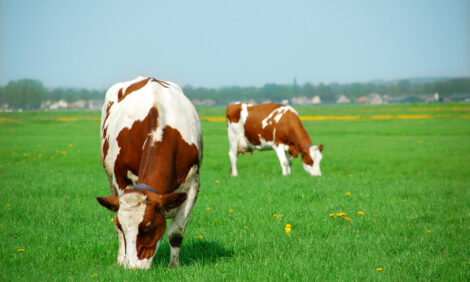



Algae-Fed Cows Could Make Healthier Beef
US - Don Van Pelt Smith thinks he has the perfect solution to two problems. He wants to cut down on CO2 emissions from his Oklahoma City power plant and he wants to eat healthier beef.Algae is the answer, he believes.Mr Smith wants to grow algae using the CO2 emissions, dewater the algae into a sludge and feed it to cattle, who will produce meat with more omega-3 fats like docosahexaenoic acid, known as DHA and eicosapentaenoic acid, known as EPA.
“It could become very big,” Mr Smith said. “It’s making the world a better place but helping keep our carbon cycle balanced.”
Oklahoma State University scientists are proving cows will eat the algae, given the right formula, and focus groups haven’t detected much change in flavor of the resulting beef. But Mr Smith needs to expand beyond a pilot study and build a commercial-sized algae farm to test his plan on larger numbers of cattle.
He hopes to build an algae farm on a plot the size of two football fields near his PowerSmith Cogeneration power plant in south Oklahoma City.
Using power plant exhaust, the algae will be grown in greenhouses that control pH level, temperature and other factors. Water will be extracted from the algae, creating a green sludge that Mr Smith wants to truck daily to a Watonga feed lot.
Mr Smith, who needs about $2.4 million for commercial testing, is appealing to investors. He recently spoke at the World Algae Congress in San Francisco.
“It’s a business that could be worth $50 billion,” Mr Smith said. He said he won’t need carbon credits to be viable commercially.
One day he hopes to see algae farms built near all US feed lots that are near power plants, making the formula a cost-effective way to create healthier beef. He said he’s produced beef high in marbling that has more than eight times the normal amount of DHA and EPA.
OSU scientist Clint Krehbiel said the trick to getting cattle to eat the algae is to control the amount of fat it contains. Cattle will stop feeding if they ingest too much dietary fat.
He sees a lucrative market for the beef, which initially would be a niche product.
“If we can produce it at a reasonable cost, I’m excited about it,” Krehbiel said. “Increasing omega-3s should make consumers more likely to purchase the products.”
Mr Krehbiel said taste testers from Texas A&M didn’t have any problem with the flavor of the beef.
“We need more studies on the flavour aspect of it,” he said. “If it ends up tasting really fishy, that would be a disadvantage.”
TheCattleSite News Desk


